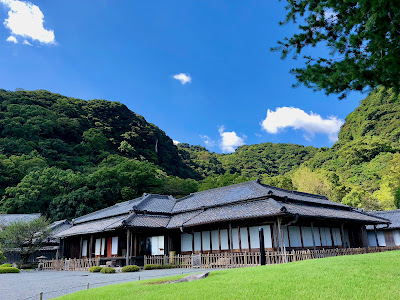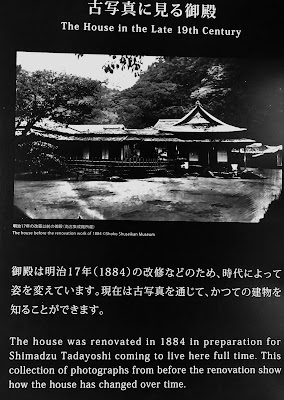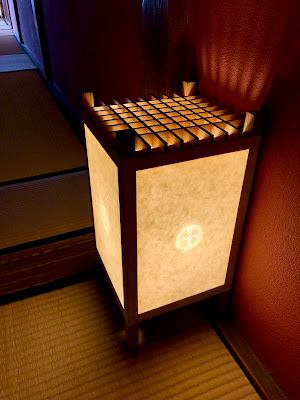目次 / Contents
1) 御殿 / The House
A. 見学前 / Before Viewing
B. 御殿内の展示より / From Displays in the House
2) 見学ツアー:前半 / The Tour : The First Half
A. ガイドさんについてゆく / Follow the Guide
B. '釘隠し' / 'Nail Cover' : 'Kugi Kakushi'
C. 鳳印の間 / Tadashige's Room
D. 廊下 / Corridor
E. 薩摩焼 / Satsuma-ware Vases
F. ドラマ / Drama
G. 五節句 / Gosekku
上記は、このセクションです。/ Above is this section.
下記は、次のセクションです。 / Below is the next section.
3) 見学ツアー:後半 / The Tour : The Second Half
H. 謁見の間 / Reception Room
I. 御居間 / Tadayoshi's Study Room
J. 化粧の間 / Dressing Room
K. 御湯殿 / Tadayoshi's Bathroom
L. 披露の間 / Welcome Room
M. 中庭 / Inner Garden
N. 神馬 / Sacred Horse
O. 古い写真 / Old Photographs
1) 御殿 / The House
A. 見学前 / Before Viewing
9月26日 ~ 10月1日、私は、姉Yと鹿児島県へ旅行しました。
今日(28日)は、"仙巌園 (センガンエン)" へ行きました。
(シマズ ミツヒサ / 1616 - 1695) によって、磯につくられた、美しい日本庭園のある別邸です。
前のセクションでは、御殿の前庭について、このセクションでは、
御殿の見学について書いています。
 |
御殿内覧チケット 御殿内の見学には、仙巌園入園チケット以外の 別のチケットが必要です。 The House Viewing Ticket A separate ticket other than the Sengan-en admission ticket is required to visit 'The House'. |
Before Viewing
From 26th of September to 1st of October I travelled with my sister Y to Kagoshima Prefecture.
Today (28th), we visited "Sengan-en".
"Sengan-en" is a villa with a beautiful Japanese garden built on the beach by Mitsuhisa Shimazu (1616 - 1695), the 19th head of the Shimazu clan and the 2nd lord of the Satsuma Domain.
Official Website : ★
In the previous section, I wrote about the front garden of 'The House', and in this section, I will write about visiting 'The House'.
 |
| 園内マップ (日本語版) : ★ Sengan-en Map in Japanese |
.jpeg) |
| 園内マップ (英語版) Sengan-en Map in English : ★ |
 |
| 正面 : 御殿 / 右 : 庭へ Front : The House / Right : To the Garden |
 |
現在の御殿 / The House, Today The House in the Early Meiji era Meiji Era : 1868 - 1912 |
 |
| 錫瓦 実際に使用された錫瓦。 現在も同じものが使用されています。 Tin Roof Tiles Tin roof tiles that were actually used. The same is still used today. |
B. 御殿内の展示より
From Displays in the House
2) 見学ツアー / The Tour
A. ガイドさんについてゆく
Follow the Guide
私達は、御殿の見学ツアーに参加しましたが
ツアーに参加しなくとも、見学はできます。
We participated in a tour of the House,
but you can visit it even if you don't participate in the tour.
B. '釘隠し' / 'Nail Cover' : 'Kugi Kakushi'
 '釘隠し' |
| ツアーの初めの説明板にもパンフレットにも '釘隠し' が強調されています。 'Nail Cover' : 'Kugi Kakushi' Both the information board at the beginning of the tour and the leaflet emphasized 'nail cover'. |
今までも、古い家やお城などに行った際、'釘隠し'を見たことがありました。
実は、新しい日本家屋でも、そのアイディアを使用していますが、数は少ないと思います。
ガイドさんを追っていったので、'釘隠し' だけを探す時間があまりなく、すべては見つけることができませんでした。
いくつかは、写真に収めることはできました。
'釘隠し'には、いろいろなアイディアがあり、なぜその柄なのか、釘を隠す意味あいだけでなく、その場所にその柄が選ばれた理由なのかなどがあるはずです。
そういう訳を知ると、日本建築の面白さが一層増すので、私は、
'釘隠し' が好きです。
残念ながら、今回は、見つけて、写真を撮ることで精一杯で、その意味合いを理解することはできませんでした。
.jpeg) |
| パンフレットの '釘隠し' 釘を隠すための飾り。 邸内に11種類あり、薩摩焼で '桜島大根' がデザインされたものや、 幸福の使者と考えられたコウモリの姿のものもあります。 もともとは、梁と柱をつなぐ釘を隠すために 考案されたこれらの精巧な装飾が、 各部屋にちょっとしたスタイルを加えています。  'Nail Cover' : 'Kugi Kakushi' on the Leaflet Originally conceived to hide the nails which join the beams and pillars together, these elaborate decorations add a hint of style to each room. There are 11 types in the residence, including a design with 'Satsumajima-Daikon' of Satsuma ware, there is also a bat figure that is considered a messenger of happiness. |
'Nail Cover' : 'Kugi Kakushi'
Until now, I have seen 'nail cover' when I went to old houses and castles.
Actually, even new Japanese houses use this idea, but I think the number is small.
I followed the guide, so I didn't have much time to look for only 'Nail Cover' : 'Kugi Kakushi', so I couldn't find them all.
I was able to capture some in the photographs.
There are various ideas for 'Nail Cover', and there must be a reason why the pattern was chosen for that place, not just the reason for the patterns and the meaning of covering the nails.
Knowing this makes Japanese architecture even more interesting, so I like 'Nail Cover''.
Unfortunately, this time I was too busy finding and photographing it to understand its implications.
 |
私の写真 / My Photographs  '桜島大根' / 'Satsumajima-Daikon' |
C. 鳳印の間 / Tadashige's Room
 |
| 鳳印の間 / Tadashige's Room この部屋は、島津家30代当主・忠重が1886年に 生まれてから12歳で上京するまで住んでいました。: ★  Tadashige's Room This room was renovated in the Taisho era and became the entrance. |
 |
| 床の間 最後のロシア皇帝・ニコライ2世 (1868 - 1918 / 在位1894 - 1917) が仙巌園に訪れた際 忠重が来ていた甲冑の複製品が飾ってあります。 Tokono-ma : Japanese Alcove When the last Russian Emperor, Nicholas II (1868 - 1918 / reigned 1894 - 1917) visited Sengan-en, Tadashige wore an armor which is displayed. |
.jpeg) |
| 忠重の子供の頃 (写真は御殿内の展示より) Photographs, Child Tadashige (Photographs From Display in the House) .jpeg) .jpeg) 聡明そうなお顔立ちですね。 You look intelligent, don't you? |
.jpeg) |
| 島津家30代当主・島津 忠重 (シマズタダヒサ / 1886 -1968) 海軍少将正二位勲一等公爵 (カイグン ショウショウ ショウニイ クンイットウ コウシャク)。 第125代天皇・明仁 (アキヒト / 1933 ~) の大叔父です。 (写真は御殿内の展示より) Shimazu Tadashige (1886 -1968) , the 30th Head of the Shimazu Clan. He was a naval officer, and rear admiral in the Imperial Japanese Navy. He was also the great-uncle of the 125th Emperor Akihito (1933 ~). (Photograph From Display in the House) .jpeg) .jpeg) |
.jpeg) |
| 忠重の結婚 妻は、伊楚子(イソコ / 1888 - 1971) 、 徳大寺 實則 (トクダイジ サネツネ / 1840 -1919) 公爵 の娘です。 (写真は御殿内の展示より) Tadashi's Marriage His wife was Isoko (1888-1971), the daughter of the Duke Tokudaiji Sanetsune ( 1840 -1919). (Photograph From Display in the House) |
E. 薩摩焼 / Satsuma-ware Vases
下記、Wikiの薩摩焼より
~~~
焼酎の土瓶の黒ぢょかは、薩摩焼の '黒もん'の1つだったのだと理解しました。
According to English Wiki about Satsuma-ware,
"Satsuma ware is a type of Japanese pottery originally from Satsuma Province, southern Kyūshū.
Today, it can be divided into two distinct categories: the original plain dark clay early Satsuma made in Satsuma from around 1600, and the elaborately decorated export Satsuma ivory-bodied pieces"
The ware is divided into gorgeous coloured called 'Shiro-mon' : 'White Pottery' : 'Satsuma ivory-bodied pieces' and miscellaneous pottery for the general public called 'Kuro-mon' : 'Black Pottery' : 'original plain dark clay early Satsuma made in Satsuma'.
I understood that the Kuro-choka (or Kuro-chokka) in the Shōchū earthenware pot was one of the 'Kuro-mon' of Satsuma ware.
The day before (27th), when we visited Satsumashuzo Brewery's Meijigura, I found about Kuro-choka, below.
 |
 |
F.ドラマ / Drama
仙巌園は、2018年、大河ドラマ:"西郷どん" のロケ地として使用されました。
御殿には、ドラマで使用された衣装などが展示されていました。
In 2018, Sengan-en was used as a filming location for the taiga drama, 2018: "Saigodon".
The costumes used in the drama are displayed in the House.
 |
.jpeg)  |
G. 五節句 / Gosekku
According to Wiki about Gosekku,
"The Gosekku (五節句), also known as sekku (節句), are the five annual ceremonies that were traditionally held at the Japanese imperial court. The origins were Japanese practices merged with Chinese practices and celebrated in Japan since the Nara period in the 8th century CE. The Japanese culture and tradition incorporated this in a unique way that spread throughout the country. The festivals were held until the beginning of the Meiji era. Some of them are still celebrated by the public today." |
 |
.jpeg) |
According to Wiki about Gosekku; Kochōhai,
"Kochōhai : on New Year's, the nobles processed before the emperor during the Jinjitsu celebrations."
 |
.jpeg) |
According to Wiki about Gosekku; Kyokusui,
"Kyokusui : on the third day of the third lunar month, courtiers floated rice wine down a stream in the palace garden. Each guest would take a sip and then write a poem.
The Hinamatsuri festival continues today."
According to Wiki about Gosekku ; Ayame no hi,
Ayame no hi : on the fifth day of the fifth month, mugwort was hung to dispel evil spirits.
Celebrated as the Japanese iris (ayame) festival at court, today it is known as Tango no sekku.
According to Wiki about Gosekku ; Kikkoden,
Kikkoden : on the seventh day of the seventh month, offerings were made during the Tanabata festival, which celebrated the annual crossing of the Weaver (Vega) and Cowherd (Altair) constellations.
According to Wiki about Gosekku ; Chōyō no en,
"Chōyō no en : on the ninth day of the ninth month, a celebration was held that originally featured chrysanthemum wine, but later became associated with the autumn rice harvest.
It is today known as the Kiku no sekku."
次のセクションも引き続き、御殿見学ツアーにつてです。
The next section continues the tour of the House.





.jpeg)
.jpeg)














.jpeg)
.jpeg)
.jpeg)


.jpeg)



.jpeg)

.jpeg)
.jpeg)




.jpeg)
.jpeg)





